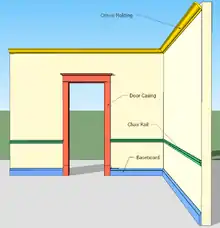Baseboard
In architecture, a baseboard (also called skirting board, skirting, wainscoting, mopboard, floor molding, or base molding) is usually wooden or vinyl board covering the lowest part of an interior wall. Its purpose is to cover the joint between the wall surface and the floor. It covers the uneven edge of flooring next to the wall; protects the wall from kicks, abrasion, and furniture; and can serve as a decorative molding.[1]

At its simplest, baseboard consists of a simple plank nailed, screwed or glued to the wall; however, particularly in older houses, it can be made up of a number of mouldings for decoration. A baseboard differs from a wainscot; a wainscot typically covers from the floor to around 1-1.5m high (waist or chest height), whereas a baseboard is typically under 0.2m high (ankle height).
Plastic baseboard comes in various plastic compounds, the most common of which is UPVC. It is usually available in white or a flexible version in several colors and is usually glued to the wall.[2] Vinyl baseboard is glued with adhesive and can be difficult to remove or to replace. It has a long lifespan, which can mean lower maintenance.[3]
Wooden baseboard can be available in untreated, lacquered or prepainted versions. Prepainted baseboards can be made from a single piece or finger jointed wood, often softwoods, while hardwoods are either lacquered, or raw for staining and made from a single piece of wood.
Radiators are sometimes installed inside or in front of baseboards (baseboard radiators). These radiators rely on hot water as their heat source.[4] Electric heating is also used in this manner. It is important to note that while you install baseboard heaters, it is not advisable to hang curtains to touch the baseboard heater as this may cause the curtains to catch fire.[5]
Country variations
Baseboards generally have typical variations depending on the country. For example, in China the baseboards are usually very low in height, are made of plastic or redwood, and have a very simple or unprofiled design. In contrast, in the UK, where they are normally referred to as skirting board not baseboard, there are a vast number of profiles available. These profiles are frequently named after the period when they were developed, such as Victorian or Edwardian.
See also
References
- "Wood Baseboard vs. Vinyl Baseboard | DoItYourself.com". Retrieved 2015-09-30.
- Holes, Leslie (2003-09-02). Creating the Built Environment: The Practicalities of Designing, Constructing and Owning Buildings. Routledge. ISBN 113581824X.
- "Wood Baseboard vs. Vinyl Baseboard | DoItYourself.com". Retrieved 2015-09-30.
- "Baseboard vs. radiator heat". Retrieved 2015-09-30.
- "Can Curtains Hang Above Baseboards? | ValidHouse.com". Retrieved 2021-02-06.